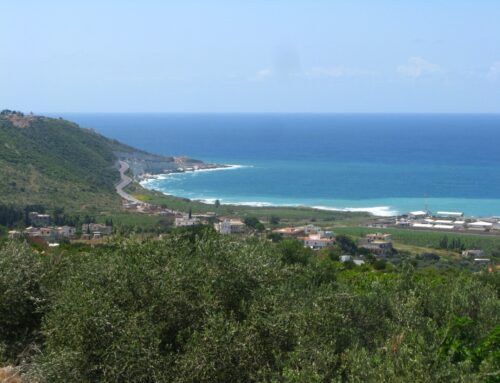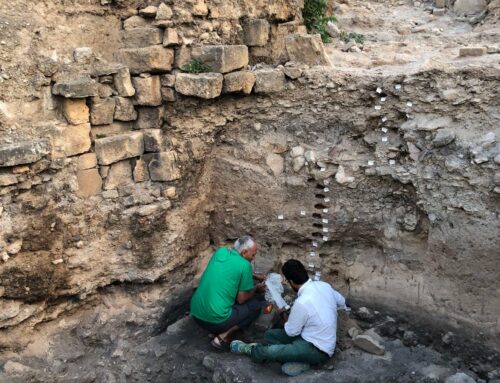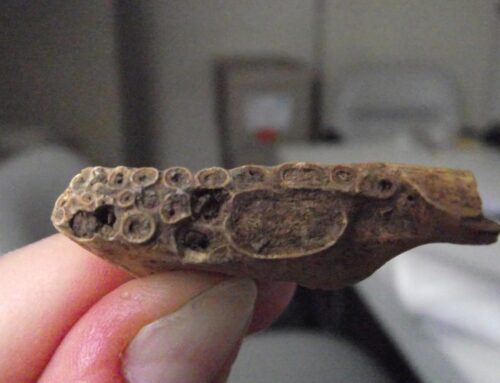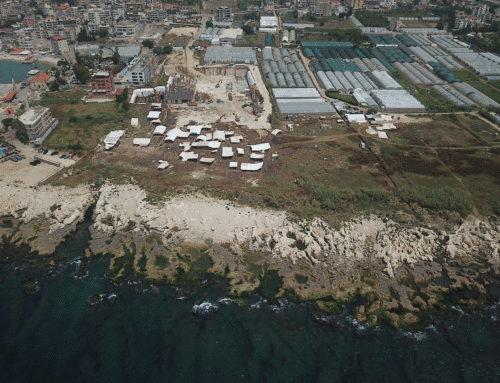CADMOS-S project – Centre National de la Recherche Scientifique (CNRS) – 2018
Alexandre Sursock and Milad Fakhri
Geophysical Survey off southern Lebanon
The CADMOS-S project was one of the first maritime archaeology programmes in Lebanon to use geophysical means of exploration. It was jointly funded, over the last two years (2015-2017), by the Honor Frost Foundation and the Centre National de la Recherche Scientifique in Lebanon.
At the time of the inception of the CADMOS-S project, the CNRS-L had been conducting coastal bathymetry surveys on-board the CANA-CNRS research vessel with its main instrument, a multi-beam echo-sounder aimed at the geomorphological recognition of the coastal seafloor from -20 to -1000m. With these specifications, this device could only render limited service to underwater archaeological exploration. In the knowledge that the coastal seabed off the cities of Saida (Sidon) and Sour (Tyre) had been subject to limited prior exploration, priority was given to get a precise and extensive description of these underwater landscapes, a task the multi-beam could handle efficiently.
Mount Lebanon
Mount Lebanon is a young, isolated massif along the Levantine coast, unique in its environment. It is blocked to the east by the Great Levant Fault, which is the seat of intense seismic movements well documented in history. Saida and Sour are located south of this massif. To the west out at sea, a vast system of reverse faults discovered during a bathymetric campaign conducted in 2003 in the framework of a French partnership (IFREMER and Institut du Physique du Globe de Paris) had to be considered within the framework of the current survey. Also worthy of note, are the deep canyons originating near the coast and carving out the maritime domain. This configuration probably explains the uplift of Mount Lebanon, a high and steep mountain, throwing itself directly into the sea. The uplift of Mount Lebanon, still active, is estimated to be of the order of 5mm / year, a figure higher than the estimated value of sea-level rise.
Saida and Sour
The Flexure of Harisa delineates the foothill line of the massif where there is an absence of coastal plain and observably tight geological folds. This line marks the limit of the vertical movements of the shore. In contrast, the coastal landscape to the south consists of alluvial plains fed mainly by the Awali and Litani rivers. In contrast to the north coast, the south coast is made up of compartments limited by East-West reverse faults descending from Mount Lebanon. Within these compartments, the phenomena of subsidence or coastal accretion are obvious and have been known since Antiquity. Sheltered behind such promontories are Saida and Sour, and the famous tombolo of Sour testifies to such accretion.
Natural Risks
Major earthquakes affecting southern coastal cities, sometimes accompanied by tsunamis, are believed to have reduced since the sixth century. The coastline at the level of Saida and Sour has thus been little affected since then except by subsidence and accretion. But the sixth century is also the beginning of the decline of these cities, especially Sour, and consequently of height of their maritime history.
Operations at Sea
The aim of the offshore operations within the CADMOS-S Project was established in August 2015. The primary objective was to identify sites of archaeological interest off Saida and Sour in order to characterize them geologically, biologically and environmentally. The operations at sea were to take place during autumn 2015 and would require 30 days at sea, equally shared between the two sites, for areas laying between contours -15 and -50m having a N-S extension of 10km and 5km wide. The team expected to map the entire submerged plateau in both cases. Whilst operations started as planned, and the area facing Saida was entirely surveyed that autumn, this was not the case at Sour, for which more survey time had to be spent in spring 2016 and then anew in 2017.
The plateau facing Saida was mapped according to the program, but at Sour the goal had to be reduced to contour -25m instead of -50m due to the significant eastward extension of the local platform. The mapping operations were much longer than expected, partly due to inclement weather conditions, but a comprehensive survey to an appropriate resolution was achieved by navigating slowly across the area (maximum 4 knots) along parallel and tightly close tracks (30 to 40m apart) over the vast plateau at -20m.
Post-processing of the multi-beam data was carried out by the Laboratory of Marine Geology and Physical Oceanography (Department of Geology, University of Patras, Greece) under the direction of Professor George Papatheodorou.
A total of 40 days at sea were devoted to the project during which two underwater remotely operated vehicles (or ROV) were employed to photograph or film structures observed on the backscatter image of the multi-beam echo-sounder and to characterize the seabed. After the acquisition of a catamaran having a draught of only 40cm, which was able to move closer to the shore among the reefs, the extreme shallow area between 0 and -15m was surveyed using a single-beam echo-sounder, thus linking the multi-beam survey with the shoreline.
All in all, a very large mass of original data has been collected. Whilst much of this has yet to be processed, it promises to provide a wealth of information to continue the archaeological research in Saida and Sour.
The preliminary results have been delivered to the authorities of the cities of Sour and Saida and the Ministry of Culture/Directorate General of Antiquities — with whom a protocol was established. The preliminary results have also been presented to an audience of archaeologists in Beirut I late 2017 as part of the international symposium “Tyre, Sidon, Byblos: Three Global Harbours of the Ancient World”.
To conclude, at least for the moment…
These two maritime cities played a critical role in the development of the history of Lebanon in Antiquity, and yet still hold many unanswered questions beneath their waters. Questions pertaining to the loss of ships during naval battle and sieges, the nature and scale of their ports and how these changed over time being effected by sea-level change, sedimentation and tectonic activity. For example a tectonic fault discovered as part of the recent survey could help resolve questions relating to the extent and timing of tectonic events in the region of Sour.
Thus, the underwater archaeological indicators that relate to the maritime history of these cities have yet to be located. Perhaps some artefacts are trapped within in the coralline platform matrix that flourished when biological conditions were favourable. Other features potentially provide indices of natural disasters (earthquakes, landslides) that may have modified the submarine landscapes over time. In order to answer these questions further investigation is necessary.





